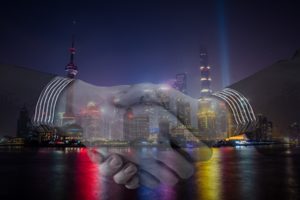16.11: Why It Matters- Globalization and International Trade
- Page ID
- 48514
\( \newcommand{\vecs}[1]{\overset { \scriptstyle \rightharpoonup} {\mathbf{#1}} } \)
\( \newcommand{\vecd}[1]{\overset{-\!-\!\rightharpoonup}{\vphantom{a}\smash {#1}}} \)
\( \newcommand{\id}{\mathrm{id}}\) \( \newcommand{\Span}{\mathrm{span}}\)
( \newcommand{\kernel}{\mathrm{null}\,}\) \( \newcommand{\range}{\mathrm{range}\,}\)
\( \newcommand{\RealPart}{\mathrm{Re}}\) \( \newcommand{\ImaginaryPart}{\mathrm{Im}}\)
\( \newcommand{\Argument}{\mathrm{Arg}}\) \( \newcommand{\norm}[1]{\| #1 \|}\)
\( \newcommand{\inner}[2]{\langle #1, #2 \rangle}\)
\( \newcommand{\Span}{\mathrm{span}}\)
\( \newcommand{\id}{\mathrm{id}}\)
\( \newcommand{\Span}{\mathrm{span}}\)
\( \newcommand{\kernel}{\mathrm{null}\,}\)
\( \newcommand{\range}{\mathrm{range}\,}\)
\( \newcommand{\RealPart}{\mathrm{Re}}\)
\( \newcommand{\ImaginaryPart}{\mathrm{Im}}\)
\( \newcommand{\Argument}{\mathrm{Arg}}\)
\( \newcommand{\norm}[1]{\| #1 \|}\)
\( \newcommand{\inner}[2]{\langle #1, #2 \rangle}\)
\( \newcommand{\Span}{\mathrm{span}}\) \( \newcommand{\AA}{\unicode[.8,0]{x212B}}\)
\( \newcommand{\vectorA}[1]{\vec{#1}} % arrow\)
\( \newcommand{\vectorAt}[1]{\vec{\text{#1}}} % arrow\)
\( \newcommand{\vectorB}[1]{\overset { \scriptstyle \rightharpoonup} {\mathbf{#1}} } \)
\( \newcommand{\vectorC}[1]{\textbf{#1}} \)
\( \newcommand{\vectorD}[1]{\overrightarrow{#1}} \)
\( \newcommand{\vectorDt}[1]{\overrightarrow{\text{#1}}} \)
\( \newcommand{\vectE}[1]{\overset{-\!-\!\rightharpoonup}{\vphantom{a}\smash{\mathbf {#1}}}} \)
\( \newcommand{\vecs}[1]{\overset { \scriptstyle \rightharpoonup} {\mathbf{#1}} } \)
\( \newcommand{\vecd}[1]{\overset{-\!-\!\rightharpoonup}{\vphantom{a}\smash {#1}}} \)
\(\newcommand{\avec}{\mathbf a}\) \(\newcommand{\bvec}{\mathbf b}\) \(\newcommand{\cvec}{\mathbf c}\) \(\newcommand{\dvec}{\mathbf d}\) \(\newcommand{\dtil}{\widetilde{\mathbf d}}\) \(\newcommand{\evec}{\mathbf e}\) \(\newcommand{\fvec}{\mathbf f}\) \(\newcommand{\nvec}{\mathbf n}\) \(\newcommand{\pvec}{\mathbf p}\) \(\newcommand{\qvec}{\mathbf q}\) \(\newcommand{\svec}{\mathbf s}\) \(\newcommand{\tvec}{\mathbf t}\) \(\newcommand{\uvec}{\mathbf u}\) \(\newcommand{\vvec}{\mathbf v}\) \(\newcommand{\wvec}{\mathbf w}\) \(\newcommand{\xvec}{\mathbf x}\) \(\newcommand{\yvec}{\mathbf y}\) \(\newcommand{\zvec}{\mathbf z}\) \(\newcommand{\rvec}{\mathbf r}\) \(\newcommand{\mvec}{\mathbf m}\) \(\newcommand{\zerovec}{\mathbf 0}\) \(\newcommand{\onevec}{\mathbf 1}\) \(\newcommand{\real}{\mathbb R}\) \(\newcommand{\twovec}[2]{\left[\begin{array}{r}#1 \\ #2 \end{array}\right]}\) \(\newcommand{\ctwovec}[2]{\left[\begin{array}{c}#1 \\ #2 \end{array}\right]}\) \(\newcommand{\threevec}[3]{\left[\begin{array}{r}#1 \\ #2 \\ #3 \end{array}\right]}\) \(\newcommand{\cthreevec}[3]{\left[\begin{array}{c}#1 \\ #2 \\ #3 \end{array}\right]}\) \(\newcommand{\fourvec}[4]{\left[\begin{array}{r}#1 \\ #2 \\ #3 \\ #4 \end{array}\right]}\) \(\newcommand{\cfourvec}[4]{\left[\begin{array}{c}#1 \\ #2 \\ #3 \\ #4 \end{array}\right]}\) \(\newcommand{\fivevec}[5]{\left[\begin{array}{r}#1 \\ #2 \\ #3 \\ #4 \\ #5 \\ \end{array}\right]}\) \(\newcommand{\cfivevec}[5]{\left[\begin{array}{c}#1 \\ #2 \\ #3 \\ #4 \\ #5 \\ \end{array}\right]}\) \(\newcommand{\mattwo}[4]{\left[\begin{array}{rr}#1 \amp #2 \\ #3 \amp #4 \\ \end{array}\right]}\) \(\newcommand{\laspan}[1]{\text{Span}\{#1\}}\) \(\newcommand{\bcal}{\cal B}\) \(\newcommand{\ccal}{\cal C}\) \(\newcommand{\scal}{\cal S}\) \(\newcommand{\wcal}{\cal W}\) \(\newcommand{\ecal}{\cal E}\) \(\newcommand{\coords}[2]{\left\{#1\right\}_{#2}}\) \(\newcommand{\gray}[1]{\color{gray}{#1}}\) \(\newcommand{\lgray}[1]{\color{lightgray}{#1}}\) \(\newcommand{\rank}{\operatorname{rank}}\) \(\newcommand{\row}{\text{Row}}\) \(\newcommand{\col}{\text{Col}}\) \(\renewcommand{\row}{\text{Row}}\) \(\newcommand{\nul}{\text{Nul}}\) \(\newcommand{\var}{\text{Var}}\) \(\newcommand{\corr}{\text{corr}}\) \(\newcommand{\len}[1]{\left|#1\right|}\) \(\newcommand{\bbar}{\overline{\bvec}}\) \(\newcommand{\bhat}{\widehat{\bvec}}\) \(\newcommand{\bperp}{\bvec^\perp}\) \(\newcommand{\xhat}{\widehat{\xvec}}\) \(\newcommand{\vhat}{\widehat{\vvec}}\) \(\newcommand{\uhat}{\widehat{\uvec}}\) \(\newcommand{\what}{\widehat{\wvec}}\) \(\newcommand{\Sighat}{\widehat{\Sigma}}\) \(\newcommand{\lt}{<}\) \(\newcommand{\gt}{>}\) \(\newcommand{\amp}{&}\) \(\definecolor{fillinmathshade}{gray}{0.9}\)Why analyze the benefits and costs of international trade?

Over time, the world has become a smaller place. Globalization is the process by which the world, previously isolated through physical and technological distance, becomes increasingly interconnected. Globalization happens through the increase in interaction between peoples around the world that involves the sharing of ideas, cultures, goods, services and investment. The last sixty years have witnessed a huge increase in globalization, but the phenomenon has been going on for much longer. Thomas Friedman describes the current trend as the third great wave of globalization in human history.
As globalization increases over time, individuals, firms, institutions, and politicians work within and across countries to define exactly how “open” they want to be. It is natural for people to want to protect their own products through tariffs or trade restrictions, while having open access to foreign markets. But if one country protects its products, its trading partners are likely to do the same. One thing is for sure, protection and openness to international trade both have income distribution effects. The key question is who reaps the benefits and who carries the burden of the system adopted by a given country.
This module may be more important than you think. The topic is international trade and includes aspects of globalization and finance, but the theory explains every transaction we conduct. Why do people work for pay instead of growing their own food, building their own house and making their own clothes? Most people are capable of painting their own homes, yet professional painters continue to make a good living. How is international trade different from domestic trade? The answer is, “not very much, only in the details.” People buy imported goods for the same reasons they buy domestic goods. And yet we often treat foreign and domestic trade as fundamentally different. A grocery chain from a nearby state has recently opened some stores in your neighborhood. How would you feel if the local government prohibited you from shopping at those new stores?
In this module, you will learn that just as buying from the local grocery store is better for most people than growing your own food, so international trade can add to your convenience and quality of life. And yet, most countries support some degree of protectionism, barriers to trade like tariffs, or quotas designed to “protect” domestic workers and companies.
As you proceed through this module, consider the following questions:
- What is comparative advantage?
- What are the gains from international trade?
- In what sense do barriers to trade protect American workers and companies?
- What are the costs of globalization? Are the costs worth it?
International trade and finance are often confused as being synonymous with globalization. Indeed, trade and international finance have contributed to globalization but they are not the same. Globalization is a process that widens, deepens and speeds-up interconnectedness between people, institutions, markets and nations. Trade and finance are two arteries through which the process of globalization flows. There are many ways to conceptualize globalization.
JUST WHOSE IPHONE IS IT?
The iPhone is a global product. Apple does not manufacture the iPhone components, nor does it assemble them. The assembly is done by Foxconn Corporation, a Taiwanese company, at its factory in Sengzhen, China. But, Samsung, the electronics firm and competitor to Apple, actually supplies many of the parts that make up an iPhone—about 26%. That means, that Samsung is both the biggest supplier and biggest competitor for Apple. Why do these two firms work together to produce the iPhone?

To understand the economic logic behind international trade, you have to accept, as these firms do, that trade is about mutually beneficial exchange. Samsung is one of the world’s largest electronics parts suppliers. Apple lets Samsung focus on making the best parts, which allows Apple to concentrate on its strength—designing elegant products that are easy to use. If each company (and by extension each country) focuses on what it does best, there will be gains for all through trade.
- Authored by: Steven Greenlaw and Lumen Learning. License: CC BY: Attribution
- Introduction to International Trade. Authored by: OpenStax College. Located at: https://cnx.org/contents/J_WQZJkO@4.2:bPub2niR@2/Introduction-to-International-. License: CC BY: Attribution. License Terms: Download for free at http://cnx.org/contents/4061c832-098...93a2cb31@11.11
- business handshake and city scene. Authored by: Tumisu. Provided by: Pixabay. Located at: https://pixabay.com/en/handshake-business-hand-2998302/. License: CC0: No Rights Reserved

